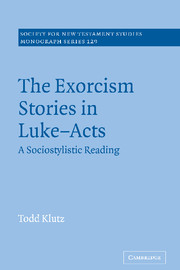Book contents
- Frontmatter
- Contents
- Acknowledgements
- List of abbreviations
- Introduction
- 1 Sociostylistics and the exorcism in Luke 4.33–37
- 2 Purity and the exorcism in Luke 8.26–39
- 3 Discipleship and the exorcism in Luke 9.37–43a
- 4 Paul, Jewish identity, and the exorcism in Acts 16.16–18
- Conclusion
- Bibliography
- Index of sources discussed
- Index of names and subjects
4 - Paul, Jewish identity, and the exorcism in Acts 16.16–18
Published online by Cambridge University Press: 22 September 2009
- Frontmatter
- Contents
- Acknowledgements
- List of abbreviations
- Introduction
- 1 Sociostylistics and the exorcism in Luke 4.33–37
- 2 Purity and the exorcism in Luke 8.26–39
- 3 Discipleship and the exorcism in Luke 9.37–43a
- 4 Paul, Jewish identity, and the exorcism in Acts 16.16–18
- Conclusion
- Bibliography
- Index of sources discussed
- Index of names and subjects
Summary
In chapter 3 my discovery of a chiastic pattern in Luke 9.1–50 was shown to have several important consequences for the interpretation of 9.37–43a in particular. That same discovery also has significant implications for my reading of the story in Acts 16.16–18. Most notably, the subordination of exorcism as a theme to Luke's interest in the death of Jesus and its implications for discipleship (Luke 9.18–27) creates an expectation that subsequent references to exorcism in Luke's volumes may likewise be part of some larger schematic structure whose primary emphasis falls on non-exorcistic concerns. But just as significant, when Luke 9.1–50 and its constituent units are read not only as part of the Lucan Gospel but also as integral components of the larger macrotextual unity of Luke–Acts, that section's concluding element – the interchange about the strange exorcist who is not associated with the twelve but none the less performs exorcisms in Jesus' name (9.49–50) – offers strong clues regarding the identity of the particular schematic structure that gives the Acts 16 story its specific rhetorical weight in Luke's argument. For reasons discussed fully below, that structure is best understood as consisting of the Jesus–Paul parallels, which, though increasingly recognised for their role in tying Luke's two volumes together into a single story, have specific features that are often overlooked.
- Type
- Chapter
- Information
- The Exorcism Stories in Luke-ActsA Sociostylistic Reading, pp. 207 - 264Publisher: Cambridge University PressPrint publication year: 2004



